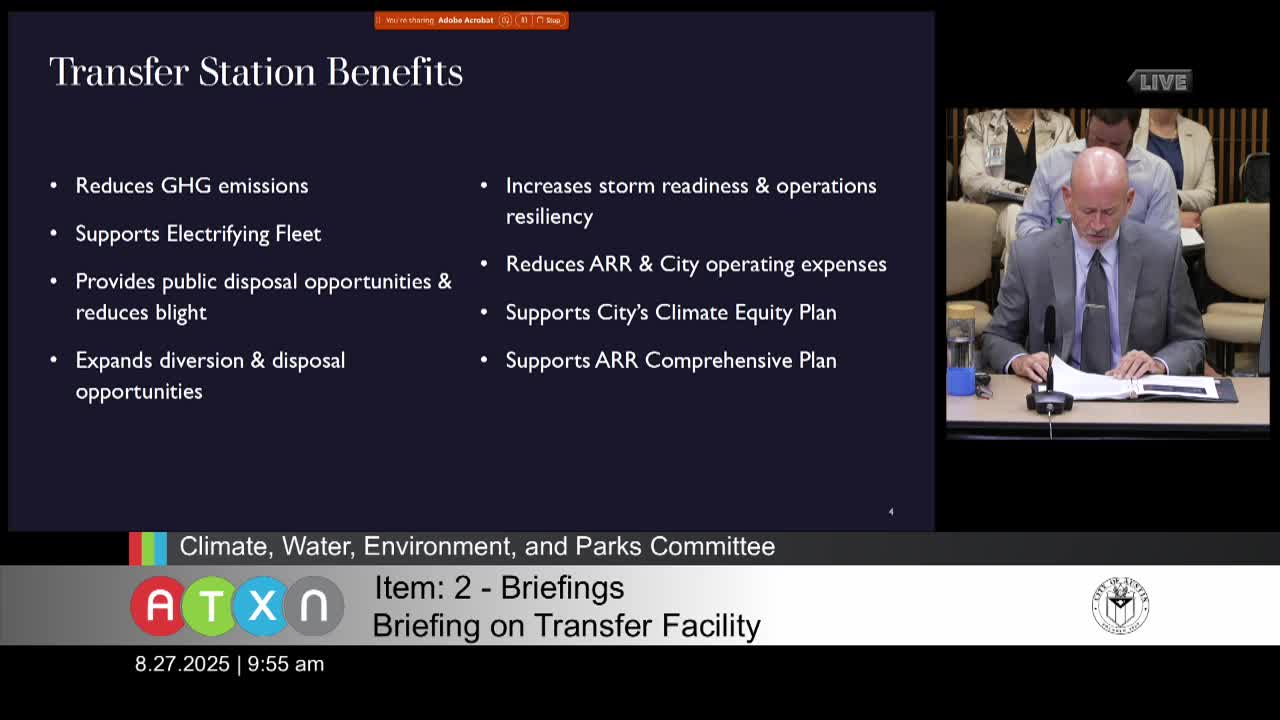City of Austin evaluates sites for new waste transfer station amid operational cost goals
August 27, 2025 | Austin, Travis County, Texas
This article was created by AI summarizing key points discussed. AI makes mistakes, so for full details and context, please refer to the video of the full meeting. Please report any errors so we can fix them. Report an error »

In a recent meeting of the Austin Climate, Water, Environment, and Parks Committee, city officials delved into the complexities of establishing a new transfer station aimed at improving waste management efficiency. The discussions highlighted the dual focus on operational cost savings and the environmental implications of such a facility.
As the meeting unfolded, officials emphasized the potential for reduced drive times, which could lead to significant savings in operational costs. However, they acknowledged that the project would also incur additional capital expenses, particularly in constructing the new facility. The analysis conducted by city staff and consultants aimed to identify suitable sites across northern Austin, evaluating factors such as route efficiency, staffing needs, and construction costs.
A key aspect of the proposal is its alignment with the city’s Climate Equity Plan, which seeks to electrify city vehicles. The committee noted that by the time the facility is operational, advancements in electric truck technology could match current diesel capabilities, further supporting sustainability goals.
The evaluation process for potential sites included a thorough examination of community impacts, with officials expressing a commitment to transparency and community engagement. They recognized the challenges of siting facilities like transfer stations, which often face opposition from local residents. To mitigate concerns, the city plans to incorporate community benefits, such as public spaces and educational opportunities, into the design of the facility.
The committee also discussed the importance of adhering to regional solid waste plans and ensuring compatibility with local land use. They highlighted the need for a balanced approach that avoids overburdening any single community with waste facilities.
Looking ahead, city officials aim to finalize a property selection by fall, with hopes of having the transfer station operational by 2030. This timeline coincides with the expiration of several key contracts related to landfill and recycling services, presenting an opportunity for increased competition among vendors and potentially lower costs for residents.
As the meeting concluded, the committee left attendees with a sense of optimism about the project’s potential to enhance waste management in Austin while addressing environmental and community concerns. The path forward will require careful navigation of both logistical and social challenges, but the city is committed to fostering a collaborative approach with its residents.
As the meeting unfolded, officials emphasized the potential for reduced drive times, which could lead to significant savings in operational costs. However, they acknowledged that the project would also incur additional capital expenses, particularly in constructing the new facility. The analysis conducted by city staff and consultants aimed to identify suitable sites across northern Austin, evaluating factors such as route efficiency, staffing needs, and construction costs.
A key aspect of the proposal is its alignment with the city’s Climate Equity Plan, which seeks to electrify city vehicles. The committee noted that by the time the facility is operational, advancements in electric truck technology could match current diesel capabilities, further supporting sustainability goals.
The evaluation process for potential sites included a thorough examination of community impacts, with officials expressing a commitment to transparency and community engagement. They recognized the challenges of siting facilities like transfer stations, which often face opposition from local residents. To mitigate concerns, the city plans to incorporate community benefits, such as public spaces and educational opportunities, into the design of the facility.
The committee also discussed the importance of adhering to regional solid waste plans and ensuring compatibility with local land use. They highlighted the need for a balanced approach that avoids overburdening any single community with waste facilities.
Looking ahead, city officials aim to finalize a property selection by fall, with hopes of having the transfer station operational by 2030. This timeline coincides with the expiration of several key contracts related to landfill and recycling services, presenting an opportunity for increased competition among vendors and potentially lower costs for residents.
As the meeting concluded, the committee left attendees with a sense of optimism about the project’s potential to enhance waste management in Austin while addressing environmental and community concerns. The path forward will require careful navigation of both logistical and social challenges, but the city is committed to fostering a collaborative approach with its residents.
View full meeting
This article is based on a recent meeting—watch the full video and explore the complete transcript for deeper insights into the discussion.
View full meeting
